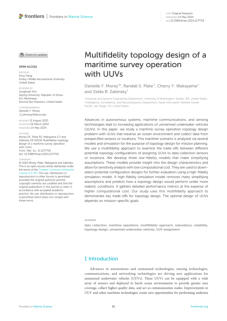Underwater mapping 2022 - Now




Authors:
Chensheng Cheng, Can Wang, Dianyu Yang, Weidong
Liu and Feihu Zhang.
SLAM (Simultaneous Localization And Mapping) plays a
vital role in navigation tasks of AUV (Autonomous
Underwater Vehicle). However, due to a vast amount of
image sonar data and some acoustic equipment’s
inherent high latency, it is challenging to implement real-
time underwater SLAM on a small AUV. This paper
presents a filter based methodology for SLAM algorithms
in underwater environments.

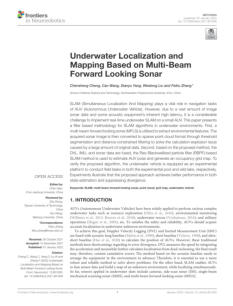

Authors:
Emir Cem Gezer, Lin Zhao, Jordan Beason, Mingxi Zhou.
Date of publication: 2022
Seafloor mapping and monitoring are essential for
creating a sustainable economy and widening our
understanding of the ocean environments. However, the
cost of conducting underwater operations has always
been high. This paper presents the progress on
developing an affordable Autonomous Under-water
Vehicle (AUV), equipped with an interferometric sonar for
seabed mapping at low altitudes or in coastal water.

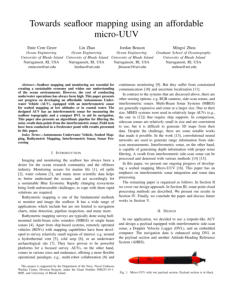

Authors:
Jinkun Wang, Fanfei Chen, Yewei Huang, John
McConnell, Tixiao Shan & Brendan Englot
Date of publication: 2022
This paper presents a novel exploration framework for
underwater robots operating in cluttered environments,
built upon simultaneous localization and mapping (SLAM)
with imaging sonar. The proposed system comprises path
generation, place recognition forecasting, belief
propagation, and utility evaluation using a virtual map,
which estimates the uncertainty associated with map cells
throughout a robot’s workspace.

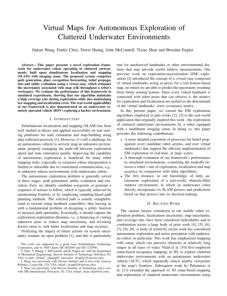

Authors:
Balint Z. Teglasy Emil Wengle, John R. Potter, and Sokratis
Katsikas
Secure digital wireless communication underwater is a
crucial issue as the security of digital systems becomes
challenged across all domains.
The authors of this document address the requirements
for security, namely, a confirmation of asset identities, also
known as "authentication". They propose and validate an
authentication protocol based on the first digital
underwater communications standard primarily applicable
to AUVs operating around offshore oil and gas facilities
but also to other underwater devices.

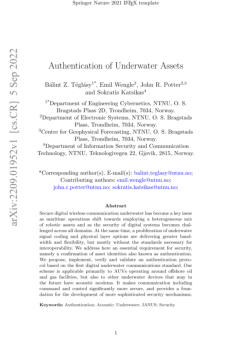

Authors: Changho Yun
To efficiently utilize nonexclusive underwater acoustic
frequencies, The authors propose an Underwater
Cooperative Spectrum Sharing (UCSS) protocol for a
centralized underwater cognitive acoustic network
consisting mainly of two parts. In the first part, to check
the random occurrence of interferers periodically, the time
domain is divided into frames that consist of a sensing and
a non-sensing sub-frame. Then, they set the ratio of the
two sub-frames to enhance the sensing rate via
simulations.

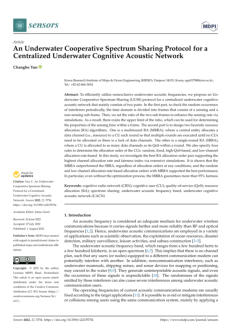

Authors: Zheng Liu, Yaoming Zhuang, Pengrun Jia,
Chengdong Wu, Hongli Xu, and Zhanlin Liu.
The automatic detection and identification of marine
organisms are critical for aquaculture resources. However,
due to the low quality of underwater images and the
characteristics of underwater biological detection, the lack
of abundant features can impede traditional hand-
designed feature extraction approaches or CNN-based
object detection algorithms, particularly in complex
aquatic environments.
Therefore, this study aimed to perform object detection in
underwater environments.

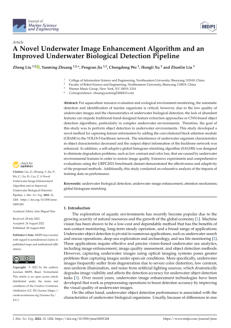

Author: Serkan Aksoy
This document explains notions such as sonar equation,
acoustic waves, underwater acoustic equations,
reverberation, Helmholtz equation, noise sources,
cavitation, and target strength.


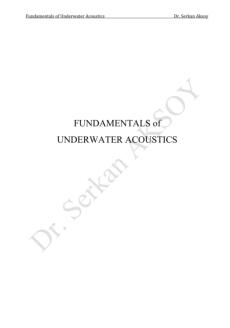

Author: Aslanbek Naziev
The authors study the (in)dependence of additivity and
homogeneity conditions in the definition of a linear
mapping between vector spaces over the same scalar
field. Unlike other works on this theme, which deal with
particular fields like real or complex numbers, we consider
the general case. That enables them to obtain an almost
complete picture.


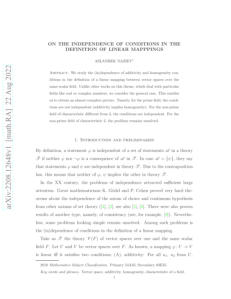

Authors:
Tuochao Chen, Justin Chan, Shyamnath Gollakota
The authors present a novel underwater system that can
perform acoustic ranging between commodity
smartphones.
To achieve this, they design a real-time underwater
ranging protocol that computes the time-of-flight
between smartphones. To address the severe underwater
multipath, they present a dual-microphone optimization
algorithm that can more reliably identify the direct path.
Their evaluations show that our system has median errors
of 0.48–0.86 m at distances up to 35 m.


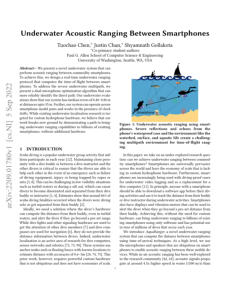

Authors:
Xiaotian Han, Peng Li, Chang Chang, Duorui Gao,
Dongquan Zhang, Peixuan Liao, Wei Wang, and
Xiaoping Xie
This document proposes solutions to the problems of
underwater wireless optical communication, which is
facing absorption and scattering problems.

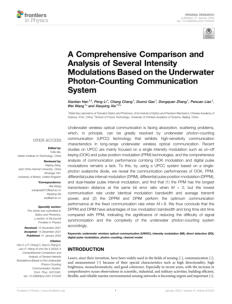

Authors:
Zhimin Li, Zibin Lin, Longsheng Zeng, Hao Wu, and Xue-
Feng Zhu
Manipulating underwater acoustic waves along the
prescribed trajectory has excellent potential for various
applications. Traditional metasurfaces for underwater
acoustic modulation usually have complex structural
designs and are complicated to manufacture. Here, we
propose a simple strategy of embedding air bubbles of
different sizes inside the polymer to manipulate the
transmitted underwater acoustic wave fields freely.


Authors:
Xenophon Dimas, Elias Fakiris, Dimitris Christodoulou,
Nikos Georgiou, Maria Geraga, Vasillis Papathanasiou,
Sotiris Orfanidis, Spyros Kotomatas, and George
Papatheodorou
The aim of this study was to present the results of the first
complete marine habitat mapping through marine
remote sensing techniques in Gyaros Island, a remote
island in the Cyclades archipelago with a great historical
and ecological value

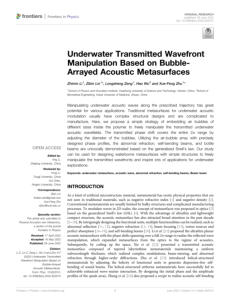


Author: Usman Ali, and Muhammad Tariq Mahmood
The authors of this paper propose a method for
underwater image restoration utilizing a technique that
incorporates the potential structural differences between
transmission maps and the guidance map.


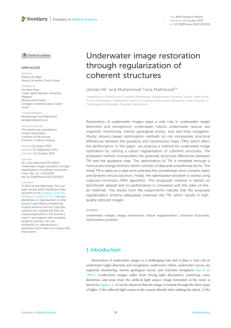

Authors: Xu Liu, Sen Lin, Zhiyong Tao
Evidence suggests that vision is among the most critical
factors in marine information exploration. Instead,
underwater images are generally of poor quality due to
color casts, lack of texture details, and blurred edges. The
authors propose the Multiscale Gated Fusion conditional
GAN (MGF-cGAN) for underwater image enhancement.
The generator of MGF-cGAN consists of Multiscale
Feature Extract Module (Ms-FEM) and Gated Fusion
Module (GFM). In Ms-FEM, they use three parallel subnets
to extract feature information, which can extract richer
features than a single branch.

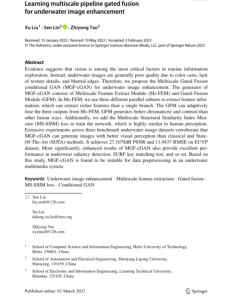

Authors:
Natalie Summers, Geir Johnsen, Aksel Mogstad, Håvard
Løvås, Glaucia Fragoso, Jørgen Berge
This document describes an Underwater Hyperspectral
Imager (UHI) deployed on an instrument-carrying
platform consisting of two interconnected mini-ROVs
(Remotely Operated Vehicle) for the mapping and
monitoring of Arctic macroalgal habitats in Kongsfjorden
(Svalbard) during the Polar Night.

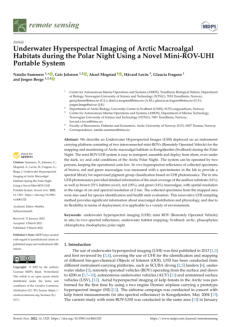

Authors: Zhen
This document thoroughly study the existing underwater
image enhancement methods and low-illumination image
enhancement methods and propose a new underwater
image enhancement network to solve the problem of
serious degradation of underwater image quality in a low-
illumination environment.

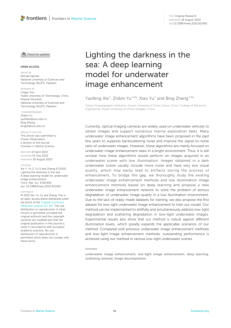

Author: Hong-Gi Kim, Jungmin Seo, and Soo Mee Kim
Unmanned underwater operations using remotely
operated vehicles or unmanned surface vehicles are
increasing recently, guaranteeing human safety and work
efficiency. Optical cameras and multi-beam sonars are
generally utilized as imaging sensors in underwater
environments.
However, the obtained underwater images are difficult to
understand intuitively, owing to noise and distortion. This
study explains the development of an optical and sonar
image fusion system that integrates the color and distance
information from two images.


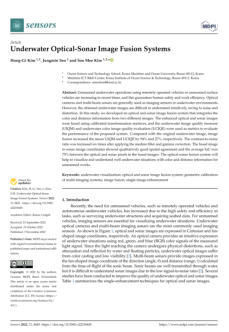

Authors: Zhenjing Zhu, Ning Hu, Junyi Wu, Wenxin Li,
Jiabao Zhao, Maofa Wang, Fanzong Zeng,
Huajie Dai, and Yongju Zheng.
This document presents a new method for estimating the
angular pulse spectrum. The process is based on the
Husimi transform of a wave field and can be realized
with a short vertical array of nondirectional hydrophones.
As a result, one obtains a diagram of the arrival pattern in
the time–angle plane. Special attention is paid to sound
scattering on a cold synoptic eddy along the waveguide.


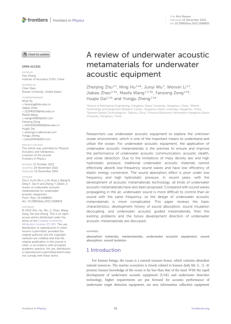

Authors: Yang Yu, and Chenfeng Qin
Underwater image enhancement faces challenges of light
scattering, absorption, and distortion. Instead of using a
specific underwater imaging model to mitigate the
degradation of underwater images, the authors propose
an end-to-end underwater-image-enhancement
framework that combines fractional integral-based Retinex
and an encoder–decoder network. The proposed variant
of Retinex aims to alleviate haze and color distortion in the
input image while preserving edges to a large extent by
utilizing a modified fractional integral filter.




Authors: Denis V. Makarov, and Leonid E. Konkov
This document presents a new method for estimating the
angular pulse spectrum. The process is based on the
Husimi transform of a wave field and can be realized with
a short vertical array of nondirectional hydrophones. As a
result, one obtains a diagram of the arrival pattern in the
time–angle plane. Special attention is paid to sound
scattering on a cold synoptic eddy along the waveguide.


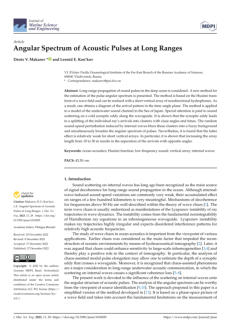

Authors:
Zefeng Zhao, Zhuang Zhou, Yunting Lai, Tenghui Wang,
Shujie Zou, Haohao Cai, and Haijun Xie
Clear underwater images are necessary for many
underwater applications, while absorption, scattering, and
different water conditions will lead to blurring and
different color deviations. This paper proposed a fusion-
based image enhancement method for various water
areas to overcome the limitations of the available color
correction and deblurring algorithms. The authors
proposed two novel image processing methods, namely,
an adaptive channel deblurring method and a color
correction method, by limiting the histogram mapping
interval.


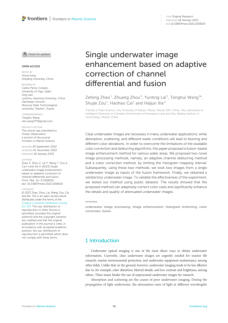

Authors: Shlomi Amitai, Itzik Klein, and Tali Treibitz
Depth estimation is critical for any robotic system. In the
past years, the depth estimation from monocular images
has shown significant improvement; however, in the
underwater environment, results are still lagging due to
appearance changes caused by the medium. The authors
suggest training using subsequent frames self-supervised
by a reprojection loss, as demonstrated above water. The
authors suggest several additions to the self-supervised
framework to cope with the underwater environment
and achieve state-of-the-art results on a challenging
forward-looking underwater dataset.


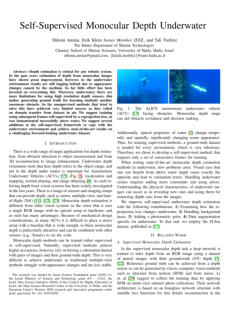

Authors: Mochou Yang, Yi Wu, and Guoying Feng
In an underwater environment, conventional imaging is
limited by low sensitivity, resulting in fuzzy images, while
ghost imaging can solve this problem. This study proposes
underwater laser ghost imaging based on Walsh speckle
patterns. According to the simulated and experimental
results, noise resistance and a low sampling rate of ghost
imaging based on Walsh speckle patterns are proved. As
the underwater environment's turbidity increases, the
image quality of ghost imaging based on Walsh speckle
patterns decreases.


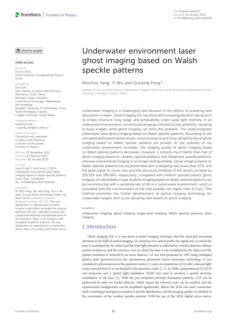

Authors: Zheyong Li, Jinghua Li, Pei Zhang, Lihui
Zheng, Yilong Shen, Qi Li, Xin Li, and Tong Li
The detection of underwater targets through
hyperspectral imagery is a relatively novel topic as the
assumption of target background independence is no
longer valid, making it difficult to detect underwater
targets using land target information directly. Meanwhile,
deep-learning-based methods have faced challenges
regarding the availability of training datasets, especially in
underwater conditions. To solve these problems, a
transfer-based framework is proposed in this paper, which
exploits synthetic data to train deep-learning models and
transfers them to real-world applications.


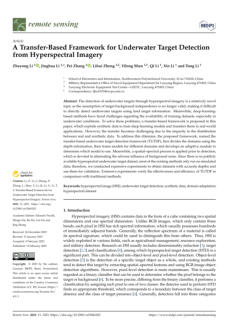

Authors:
Yang Guan, Xiaoyan Liu, Zhibin Yu, Yubo Wang, Xingyu
Zheng, Shaoda Zhang, and Bing Zheng
Underwater image enhancement is a fundamental
requirement in the field of underwater vision. Along with
the development of deep learning, underwater image
enhancement has made remarkable progress. However,
most deep learning-based enhancement methods are
computationally expensive, restricting their application in
real-time large-size underwater image processing. The
authors propose a model based on a generative
adversarial framework for large-size underwater image
enhancement to solve these problems.


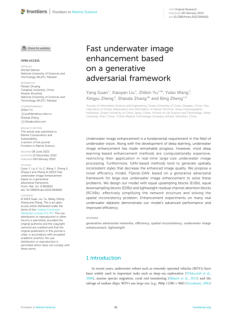

Authors: Yelena Randall, and Tali Treibitz Yan
The authors collected forward-looking stereo-vision and
visual-inertial image sets with two underwater imaging
platforms, a stereo camera rig, and an ROV in the
Mediterranean and Red Sea. To their knowledge, there is
only one other public dataset in the underwater
environment with this camera-sensor orientation. These
datasets are critical for developing several underwater
applications, including autonomous obstacle avoidance,
visual odometry, 3D tracking, Simultaneous Localization
and Mapping (SLAM), and depth estimation through
deep learning.


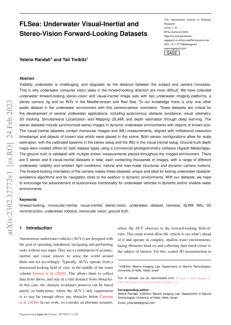

Authors:
Yuanheng Li, Shengxiong Yang, Yuehua Gong, Jingya
Cao, Guang Hu, Yutian Deng, Dongmei Tian, and
Junming Zhou
Unpaired Image-to-Image Translation using Cycle-
Consistent Adversarial Networks, also known as
CycleGAN, has been broadly studied regarding
underwater image enhancement, but it is difficult to apply
the model because it can be difficult to train if the dataset
used is not appropriate. In this article, the authors devise a
new method of building a dataset and choosing the best
images based on the widely used Underwater Image
Quality Measure (UIQM) scheme to create the dataset.


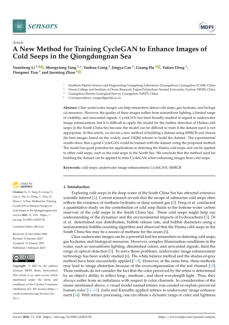

Authors:
Shijie Xu, Rendong Feng, Pan Xu, Zhengliang Hu, Haocai
Huang, and Guangming Li
Underwater environment observation with underwater
acoustic tomography has been considerably developed in
recent years. Moving sound transmission can obtain the
observation of entire spatial area with sound station
moving. Various internal structures, unique surface and
submarine boundaries and changing environment
constitutes a complex acoustic propagation channel. This
paper focus on the inversion method and signal
resampling for sound moving transmission. Also, the
current field in three-dimensional (3D) scale is also studied.


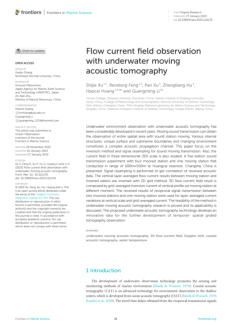

Authors:
Marios Xanthidis, Bharat Joshi, Monika Roznere, Weihan
Wang, Nathaniel Burgdorfer, Alberto Quattrini Li,
Philippos Mordohai, Srihari Nelakuditi, and Ioannis Rekleitis
The authors of this paper discuss how to effectively map
an underwater structure with a team of robots
considering the specific challenges posed by the
underwater environment.



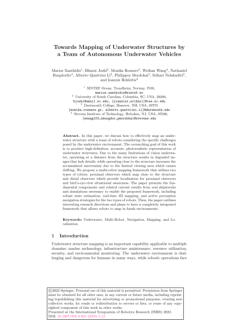

Authors:
Shiying Feng, Xiaofeng Li, Lu Ren, Shuiqing Xu
Autonomous navigation of unmanned aerial vehicles
(UAVs) is widely used in building rescue systems. As the
complexity of the task increases, traditional methods based
on environment models are hard to apply. this paper
proposes a reinforcement learning (RL) algorithm to solve
the UAV navigation problem.





Authors: Daniel Short, Tingjun Lei, Chaomin Luo,
Daniel W. Carruth, ZhumingDaniel
Many underwater image enhancement algorithms have
been proposed in the past few years to suppress
backscattering noise and improve the signal-to-noise ratio
of underwater images. However, these algorithms are
mainly focused on underwater image enhancement tasks
in a bright environment. Thus, it is still unclear how these
algorithms would perform on images acquired in an
underwater scene with low illumination. The authors
propose a new underwater image enhancement network
to bridge this gap and solve the problem of degradation
of underwater image quality in a low illumination
environment.



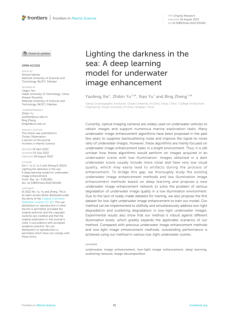

Author: Yian Wang
An underwater target ranging and size measurement
system based on binocular vision is proposed to measure
the distance and size information of underwater targets
accurately. The underwater binocular calibration method
is used to obtain the underwater parameters of the
binocular camera, and the underwater images are
calibrated to make them coplanar and aligned.




Authors: Wei Song, Yaling Liu, Dongmei Huang, Bing
Zhang,Zhihao Shen, & Huifang Xu
This paper aims to systematically review underwater
image restoration technology, bridging the gap between
shallow-sea and deep-sea image restoration fields through
experimental analysis. The authors first categorize shallow-
sea image restoration methods into three types: physical
model-based methods, prior-based methods, and deep
learning-based methods that integrate physical models.
The core concepts and characteristics of representative
methods are analyzed. The research status and primary
challenges in deep-sea image restoration are then
summarized.


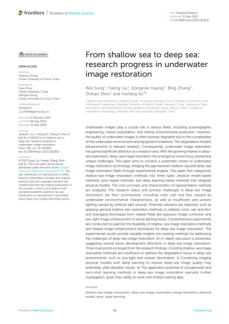

Authors:
Xiaoyang Bai, Zuodong Liang, Zhongmin Zhu, Alexander
Schwing, David Forsyth, & Viktor Gruev
Monitoring water properties using autonomous
underwater sampling robots remains a significant
challenge due to a lack of underwater geolocalization
capabilities. The authors present a new method for
underwater geolocalization using deep neural networks
trained on approximately 10 million polarization-sensitive
images acquired globally, along with camera position
sensor data.


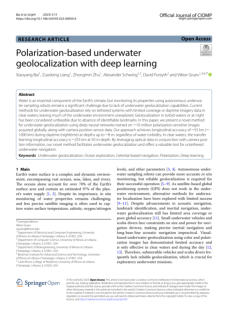

Authors:
Tuochao Chen, Justin Chan, & Shyamnath Gollakota
The emergence of waterproof mobile and wearable
devices designed for underwater activities opens up
opportunities for underwater networking and localization
capabilities on these devices. The authors present the first
underwater acoustic positioning system for smart devices.
Unlike conventional systems that use floating buoys as
anchors at known locations, they design a system where a
dive leader can compute the relative positions of all other
divers, without any external infrastructure.


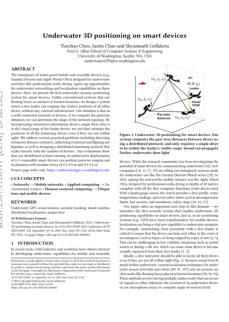

Authors: Xuanyao Bai, Kailun Wen, Donghong Peng,
Shuangqiang Liu,and Le Luo
The objective of this study is to explore the measurement
principles and detection methods of atomic
magnetometers, and it also examines the technological
means and research progress of atomic magnetometers in
various industrial fields, including magnetic imaging,
material examination, underwater magnetic target
detection, and magnetic communication. Additionally, this
study discusses the potential applications and future
development trends of atomic magnetometers.



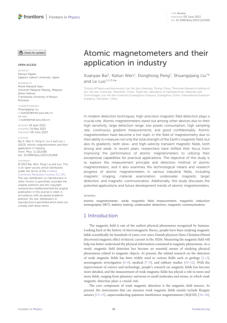



Click on the
octopus to return to
the top of the page


Author: Yaofeng Xie, Zhibin Yu, Xiao Yu, & Bing Zheng
This article proposes a new underwater image
enhancement network designed to address the
challenges of enhancing images captured in low-light
underwater environments. It explains the limitations of
existing algorithms, the need for a specialized approach,
and the creation of a new dataset to train the proposed
model. It also highlights the effectiveness and robustness
of the new method through experimental results,
emphasizing its superior performance compared to
previous methods.


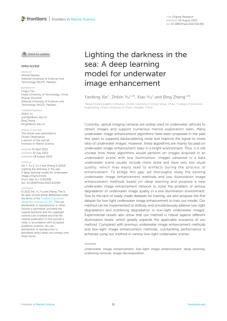

Authors: Xuebo Zhang , Haixin Sun, & Arata Kaneko
This paper highlights the significance of marine
environment and hydroacoustic data collection for
military, economic, and ecological purposes. It discusses
the challenges environmental interference poses to
underwater communication and target detection and
emphasizes the need for advanced technical solutions to
improve detection and identification capabilities. The
paper also underscores the importance of sound wave
technology and signal processing in ocean exploration.



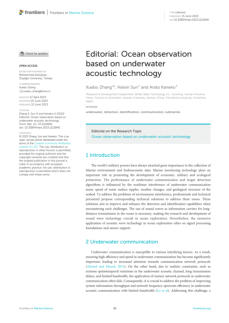

Authors: Leonidas Alagialoglou, Ioannis Manakos, Sofia
Papadopoulou, Rizos-Theodoros Chadoulis, &
Afroditi Kita
This study explains the effectiveness of different artificial
intelligence (AI) techniques for mapping underwater
aquatic vegetation (UVeg) using remote sensing data. It
evaluates the performance of classical AI tools and a
modern AI tool (Segment Anything Model, SAM) in the
context of few-shot learning with limited annotation. The
results highlight the superior performance of the SAM
model for airborne imagery but also note its challenges
for spaceborne imagery, providing researchers and
practitioners with insights into the strengths and
limitations of different AI models for UVeg mapping.

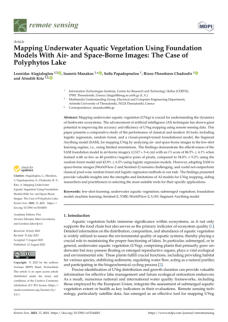

Authors: Shaowei Zhang, & Zhiqun Daniel Deng
This document overviews the advancements and
research in deep-sea exploration and observation
technology. It highlights the development of sophisticated
sensors and equipment for studying deep-sea
environments, such as seabed samplers and MEMS
sensors. The text also discusses specific technologies and
methods, such as atmospheric evaporation waveguide
communication and dual-axis rotary modulation inertial
navigation systems, that enhance ocean exploration
capabilities. Additionally, it mentions a study on
evaporation duct properties in the East China Sea,
emphasizing the importance of understanding this
phenomenon for electromagnetic wave propagation.

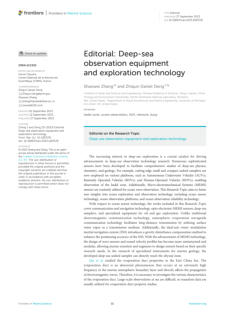

Authors: Ziyang Wang, Liquan Zhao, Tie Zhong, Yanfei
Jia, & Ying Cui
This paper describes a proposed solution for improving
the quality of underwater images using a generative
adversarial network (GAN) with multi-scale and attention
mechanisms. It explains the problem of degraded
underwater images and introduces various modules and
techniques integrated into the GAN to enhance image
quality. It also mentions the evaluation of the proposed
method using specific datasets and highlights the superior
performance of the enhanced images compared to other
methods.

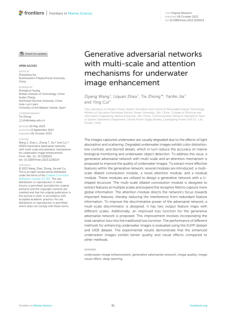

Authors: Shuo Pang, Ye Li, Liang Xiao, Francisco Rego, &
Teng Ma
This paper intends to inform and highlight the importance
and advancements of unmanned marine vehicles (USVs
and UUVs) in ocean observation, particularly in extreme
environments like the deep sea and polar regions. It aims
to showcase recent technological advancements and
future implications in areas such as sensing, control,
navigation, and communication of these vehicles,
emphasizing their role in enhancing the quantity and
quality of oceanographic data collected.

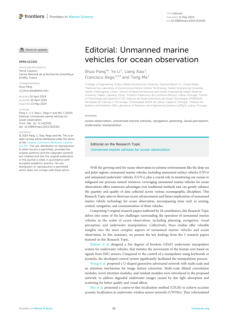

Authors: Danielle F. Morey, Randall S. Plate, Cherry Y.
Wakayama, & Zelda B. Zabinsky
This study focuses on optimizing maritime survey
operations' topology using unmanned underwater
vehicles (UUVs). It employs a multi-fidelity approach to
evaluate different configurations for assigning UUVs to
data collection sensors or locations. That involves using
both low-fidelity models, which simplify assumptions to
allow for sensitivity analysis with low computational cost,
and a high-fidelity simulation model, which provides
detailed performance metrics under more realistic
conditions.

